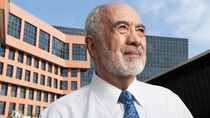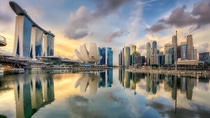Chi siamo
Staging a green revolution

November 26, 2010: Cate Blanchett stands on the roof of an old harbor building in Sydney known as “The Wharf,” the home of the Sydney Theatre Company. Immediately after becoming co-artistic directors of the theater, the Hollywood star and her husband set themselves the ambitious goal of transforming the heritage structure into a showcase for green building. Now, they are celebrating a major milestone with the installation of the second largest photovoltaic rooftop array in Australia. A lot has happened since then.
When Hollywood star Cate Blanchett and her husband, playwright and director Andrew Upton, became co-artistic directors of the Sydney Theatre Company (STC), they not only focused on the repertoire, but also on the conversion of the heritage building housing the theater. With the “Greening the Wharf” project, they wanted to combine their two great passions: art and climate protection. “Theater is very much engaged in the time and place in which it is made,” says Cate Blanchett, explaining her motivation for the project on the STC’s site www.greeningthewharf.com. “And the greatest challenge facing us as a species at the moment is climate change. We felt that, as a theater company, if we did not engage with this incredible challenge we all face, then very quickly we would become irrelevant.”
Their goals are ambitious: to produce 70% of the electricity required by the theater and its restaurant onsite and to save 11.3 million liters of water each year – enough to fill four Olympic-size swimming pools. To achieve this, the Greening the Wharf project team focuses on measures such as an automated energy management system for heating, ventilation and air conditioning and energy-efficient stage lighting. “The project is ambitious and broad in scope,” explains Paul O’Byrne, STC’s Director of Community Programs and the man in charge of implementing Greening the Wharf.
In 2010, the building project marked its first major milestone: the rooftop installation of Australia’s second largest photovoltaic rooftop array. The 1,906 solar panels now produce about 427,000 kilowatt hours of electricity annually. To meet its water conservation targets, the theater installed a sophisticated rainwater recycling system. A gigantic tank under the pier supplies all the non-drinkable water used by the STC and its restaurant “The Bar at the End of the Wharf”. Now, drinking water is no longer flushed down the toilet.
These easy-to-implement measures have been highly effective, reducing the STC’s carbon footprint. With these results, the theater’s management has demonstrated that older heritage buildings can be ecologically transformed. “We believe that change is possible without a correlating loss of quality,” Blanchett said at a panel discussion called “Creating a Climate for Change”.
Waste is turned into biogas
Their drive for innovation did not end with the theater; Blanchett, Upton and a support team of consultants also investigated how to make the restaurant more environmentally friendly. Today, organic waste from the restaurant kitchen is converted into energy and fertilizer, while other waste is turned into biogas. “We are thrilled that the level of waste sent directly to the landfill by the theater is being reduced,” says Patrick McIntyre, General Manager of the STC. The system had a positive impact almost as soon as it was installed, with a significant reduction in the amount of waste thrown away. Promoting real changes in behavior and attitude is one of the more challenging goals of Greening the Wharf. As Blanchett explains: “One of the key roles of theater and the arts more broadly is to stimulate social change by bringing vision to action through forum, experimentation and debate.” The STC has developed a model that resonates far beyond the walls of the old harbor building: Not only does it aim to engage the neighboring district of Barangaroo and create a modern wharf area here, it also wants to inspire other art and cultural organizations around the world.

To make these goals possible, around $5.2 million (€4 million) has been invested in Greening the Wharf, provided by private donors as well as partners from politics, business and academia. The project was also supported by the Australian government’s “Green Precincts Program”. For project manager O’Byrne, the money is well invested: “The full project impact will require a few more years’ data, but we know that the investment is already significantly reducing the financial burden that increasing utility costs add to our annual budget.”
Greening the Wharf has provided the theater with an even more promising future ecologically, economically and socially. This achievement has recently been publicly recognized: Greening the Wharf has seen Cate Blanchett – already the recipient of an Oscar and two Golden Globes – honored further. Along with Andrew Upton, she was awarded two Green Globe Awards in 2010, one for Sustainability Excellence and one for Community Sustainability.
BASF's new North American headquarters
Lowering the energy consumption of buildings is also an important goal for BASF. Its new North American Headquarters in Florham Park, New Jersey, which opened in May 2012 and provides room for 1,400 employees, is one example of BASF’s commitment in this regard. More than 30 BASF products were used during the construction of this 30,200 square meter (325,000 square foot) building. It meets the highest environmental standards and was designed to fulfill the requirements of the United States’ Green Building Council’s Platinum LEED® certification (Leadership in Energy and Environmental Design), which promotes sustainable construction techniques.
One of the special features of the headquarters is the efficient use of natural resources through intelligent systems. In comparison to conventional buildings, this reduces water usage by at least 40% and energy consumption by more than 20%. Furthermore, at least 20% of the materials used come from recycled components. This is even true for the furniture: chairs were partly crafted from old plastic bottles, with each seat containing 111 recycled items of packaging.
The award-winning BASF North America Headquarters Building has many sustainable aspects. Turner Construction built this 325,000 square foot building. Paul M. Parmentola at Turner Construction attributed the success to two factors: The good chemistry between members who share vision on sustainability; the other is solutions such as the BASF's roofing system and Green Sense® Concrete program.



